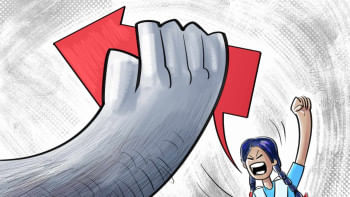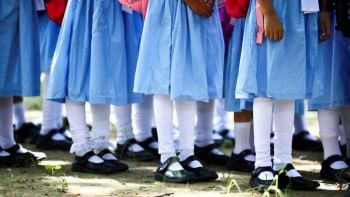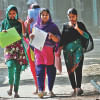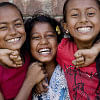Are we doing enough to make education safe for girls?

When the idea of a routine is established in a child's life, it almost turns into a mental checklist and usually sticks with them into adulthood (a mantra of sorts)—a checkbox to tick through before walking through the door. In our time as schoolgirls, the checklist comprised of making sure we have all our books, packed our lunch, wore our ID cards, and not to stay in an empty classroom or in the presence of a male teacher or staff alone in a room. What seems like an innocent ritual actually serves as a harsh reminder of how girls aren't safe anywhere, even in their educational institutions.
According to a survey conducted by Plan International in 2022, 74 percent of the total 2,232 female participants aged between 10 and 24 years, reported incidents of violence and harassment at educational institutions. Reportedly, children in Khulna division face the highest instances of violence and harassment (89.7 percent), followed by Barishal (80 percent) and Rajshahi trailing after closely at 78.8 percent, the research said.
While the statistics may seem glaring, one needs to remember that these are only some of the reported cases. The actual number of cases that are intentionally swept under the rug or hidden, influenced by the fear of social ostracisation or intimidation, may be even more drastic.
When it comes to identifying the perpetrators, teachers and staff members usually make up the bulk of the culprits. Earlier this month, in Khagrachhari, an Indigenous schoolgirl was sexually assaulted by her teacher, Abul Hasnat Muhammad Sohail Rana, who according to news reports, had been arrested in a case of attempted rape of a 10th-grader in February 2021. After his release, he returned to work at the same school despite protests from other students. Furthermore, according to multiple reports, a Kushtia school's investigation in 2018 found that Rana had sexually harassed several students.
The Khagrachhari rape case echoes the case of Nusrat Jahan Rafi, a madrasa student from Feni who was set ablaze when she refused to withdraw a sexual assault case she had filed against her principal, Siraj Ud Doula. Another instance occurred when two teachers of St Scholastica's Girls' School and College in Chattogram city's Patharghata area were sued for sexually abusing a fifth-grade schoolgirl for over a year. Whenever she tried to resist them, they reprimanded her in class and threatened to fail her in exams.
It is important to note that not only were the perpetrators inherently responsible for the safety and well-being of the students, but that these people, even after violating the conditions of their duties, were put in a position of power once again to be able to continue their wrongdoings and put other children through the same horrors.
While a higher number of cases reported were from outside Dhaka, it would be wrong to conclude that this issue is prevalent only outside the capital. In February of this year, Murad Hossain Sarkar, a senior teacher of Viqarunnisa Noon School and College's Azimpur branch in Dhaka, was placed on a two-day remand in a case lodged for allegedly sexually harassing a student.
This goes to show that children, most of whom are girls as per the reported cases, are not safe to go to school anywhere. The perpetrators are not just teachers or administrative staff but other trusted individuals as well (within or around the schools) and even other children themselves, which begs the question—who or what do we blame for this? And why do a large number of victims continue to stay silent for days, months or (as the St Scholastica's case illustrates) even years?
While the perpetrators, and especially the adults, are of course to be blamed, the culture surrounding young girls, the objectification they are subjected to, and the questions surrounding the validity of their autonomy in our society at large create the perfect recipe for this systemic disaster. The aforementioned cases highlight the systemic issues that are prevalent within our education system. Even if the students do speak up, they usually face more repercussions than the culprits themselves. Generally, corporal punishment and blackmail are used alongside threats as intimidation devices. Girls may not even be aware that they are being abused, or may worry that they are going to face consequences for speaking up.
This further contributes to the culture of silencing the victims, as they do not have the provisions to obtain justice on an administrative level in their educational institutions. Often, the overall reputation of certain teachers for being good educators, or their popularity with other students, leads to people around the victim questioning their motivations and resorting to virtue signalling in favour of the perpetrator. It may even go as far as to publicly humiliate the victim, and assassinate their character in an attempt to restore the perpetrator's image—leading to further vilification. And thus, the cycle of horror goes on.
What certainly does not help is that the Parliament of Bangladesh passed the Child Marriage Restraint Act in 2017 with a special provision allowing an underage boy or an underage girl to get married in some exceptional cases. This provision may just legitimise the marriage of a child who happens to be a rape survivor, with the rapist within the scope of "special provision" as well.
An estimated 60 percent of the country's schools and colleges are yet to form sexual harassment complaint committees despite a High Court directive issued a decade ago. Even with the very few institutions that have created such anti-sexual harassment cells, students have reportedly been confused about where they should register a complaint, and the cells only existed on paper. At this point, it is impossible to ask what could possibly take an institution over a staggering 10 years to form a committee that seeks to ensure the safety and wellbeing of their students.
All in all, the narrow avenues of holding the perpetrators accountable traps the young girls in such a situation where they generally have to continue their education in the presence of their abusers, or face dire consequences or stigmatisation if they choose to speak up. The impacts of such violence are not limited only to the particular victims who experience the ordeal themselves, but rather impact the entire female demographic, and their pursuit of education which hinges on the decisions taken by parents, guardians or society at large. Consequently, girls are robbed of the opportunity to further or even pursue their education. Another survey by Plan International, conducted with the participation of 4,305 households, found that around 35.3 percent of parents think that fear of sexual harassment is a big factor that leads parents to marry off their underage daughters while 25.6 percent of parents get their underage daughters married out of concerns of social exclusion.
So, what can be done? What is certainly non-negotiable is the need for safe, unbiased, and inclusive committees to ensure confidential and safe reporting mechanisms in schools. Students must never feel unsafe or vilified if and when they choose to report cases of any form of sexual violence. Moreover, the members of a committee should come from a diverse range of backgrounds, equipped to even deal with such matters with utmost sensitivity. The children should also be familiarised with them otherwise they might not trust them enough to report incidents. In case a member of the committee itself is at fault, contingent procedures must be in place.
In Bangladesh, the implementation of comprehensive sexuality education is severely restricted given how the subject matter is viewed through a heavily stigmatised lens. Therefore, even if implementation of comprehensive sex education in all schools is a faraway idea, rudimentary knowledge regarding "good touch/bad touch" and consent should be disseminated across students, administrators, staff, and parental bodies.
In dealing with "women's issues," the foremost idea that almost always shines through is that women need to have access to education, and that education is the only sustainable way for them to gain agency. However, the systemic barriers that hinder girls' pursuit of education have continued to remain deeply ingrained in our society. Every year, we are shown statistics of women excelling in their board examinations and reports of their accomplishments, which are portrayed to be a direct result of all the efforts made by said society to empower girls, but are we as a society doing enough to remove the barriers that have prevailed?
Syeda Afrin Tarannum is a sub-editor at Campus, Rising Stars, and Star Youth.
Fatima Jahan Ena is a member of the Editorial team at The Daily Star.
Views expressed in this article are the author's own.
Follow The Daily Star Opinion on Facebook for the latest opinions, commentaries and analyses by experts and professionals. To contribute your article or letter to The Daily Star Opinion, see our guidelines for submission.


 For all latest news, follow The Daily Star's Google News channel.
For all latest news, follow The Daily Star's Google News channel. 










Comments